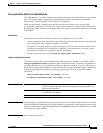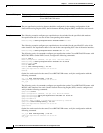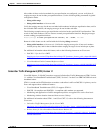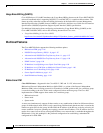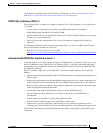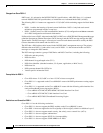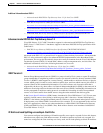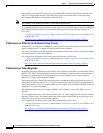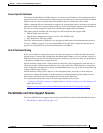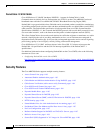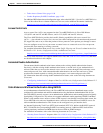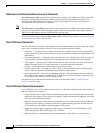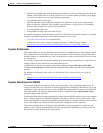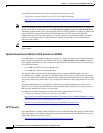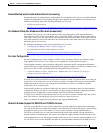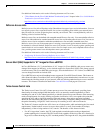
1-101
Cisco uBR7200 Series Universal Broadband Router Software Configuration Guide
OL-2239-05
Chapter1 Overview of Cisco uBR7200 Series Software
cops tcp window-size
Source Specific Multicast
The Source Specific Multicast (SSM) feature is an extension of IP multicast, where datagram traffic is
forwarded to receivers from only those multicast sources that the receivers have explicitly joined. When
SSM is used, only source-specific multicast distribution trees (no shared trees) are created.
SSM is a datagram delivery model that best supports one-to-many applications, also known as broadcast
applications. SSM is the core networking technology for the Cisco implementation of the IP Multicast
lite suite of solutions targeted for audio and video broadcast application environments.
This feature module introduces the following Cisco IOS components that support SSM:
• PIM-SS (PIM source specific)
• Internet Group Management Protocol Version 3 lite (IGMP v3lite)
• URL Rendezvous Directory (URD)
The Cisco implementation of SSM will soon be deployed with Internet Group Management Protocol
Version 3 (IGMPv3) support. Cisco developed IGMP v3lite and URD to support the deployment of
applications using SSM services before the introduction of IGMPv3.
Stub IP Multicast Routing
When you use PIM in a large network, there are often stub regions over which the administrator has
limited control. To reduce the configuration and administration burden, you can configure a subset of
PIM functionality that provides the stub region with connectivity, but does not allow it to participate in
or potentially complicate any routing decisions.
Stub IP multicast routing allows simple multicast connectivity and configuration at stub networks. It
eliminates periodic flood-and-prune behavior across slow-speed links (ISDN and below) using dense
mode. It eliminates that behavior by using forwarded IGMP reports as a type of Join message and using
selective PIM message filtering.
Stub IP multicast routing allows stub sites to be configured quickly and easily for basic multicast
connectivity, without the flooding of multicast packets and subsequent group pruning that occurs in
dense mode, and without excessive administrative burden at the central site.
For configuration information, refer to the following document on Cisco.com:
• “Configuring IP Multicast Routing” chapter in the Cisco IOS IP Configuration Guide, Release 12.2
guide on Cisco.com:
http://www.cisco.com/univercd/cc/td/doc/product/software/ios122/122cgcr/fipr_c/ipcpt3/
PacketCable and Voice Support Features
The Cisco uBR7200 Series supports the following PacketCable and PacketCable MultiMedia feature:
• PacketCable 1.0 With CALEA, page 1-102



